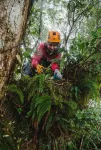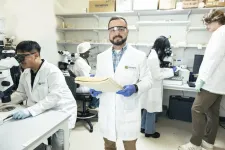(Press-News.org) In certain trees, soils can form along branches and can support varied plant and animal life. However, what conditions these ‘canopy soils’ form in, and what kind of biodiversity they support, has been difficult to study.
Now, researchers from Utah State University and Imperial College London have surveyed dozens of trees in Costa Rica, mapping the canopy soils to determine where they form and how they might be affected by a changing climate. The results are published in Geoderma.
First author Jessica Murray, from Utah State University, said: “We found canopy soils most often form in cool, foggy areas in these tropical forests where there are large, old trees. Unfortunately, this describes some of the most at-risk forest types, which are threatened by changing climate and deforestation.”
Her PhD supervisor Dr Bonnie Waring, now at the Department of Life Sciences (Silwood Park) at Imperial, added: “Canopy soils in tropical cloud forests are rich in life and nutrients and could be large carbon stores. The fact it’s taken until now to even start to recognise their importance is amazing – not least because we may be destroying them faster than we can study them.”
Unique habitat
To study the soils, Murray climbed trees in six primary (i.e. untouched) rainforest sites in Costa Rica. These included sites along one of the last continuous lines of primary rainforest in South America, with elevations ranging from 67–2700 m above sea level and mean annual temperature ranging from 10–24 ◦C, plus variable rainfall and fog abundance.
She scaled trees up to heights of 15-30m to find canopy soils and measure their biodiversity and soil chemistry. This revealed a great diversity in composition, even along a branch and between trees close to each other – making each soil mat (soil + moss + plants) its “own little forest”.
These forests-in-miniature contain abundant plant and animal life, with invertebrates also supporting varied bird species. The plants include epiphytes – plants that live on other plants – which are especially common in cloud forests.
Canopy soils are nutrient-rich, thanks to mosses that convert nitrogen from the air, meaning the epiphytes that live there are healthier than other types that live directly on tree bark (commonly known as air plants). There is even evidence that the trees themselves take advantage of the soils, growing roots into them to obtain some of the nutrients.
Under threat
The results show canopy soils in general were most abundant in higher, cooler areas with plenty of fog and larger, older trees. While it’s difficult to know exactly how long they take to form, the team estimate some soil mats could take more than a hundred years to reach full maturity.
Unfortunately, this means they could be difficult to replace if they are lost. As the climate heats up, the fog cloud levels are rising in these forests, meaning many soils could disappear and there may not be trees high enough to replace them.
Many such forests have also been logged or face future deforestation, and even where forests have been allowed to recover (secondary forests), few if any would have had sufficient time to regrow mature canopy soils.
Murray said: “Determining the contribution of canopy soils to forest carbon budgets is important for assessing their role in mitigating climate change. It could also be an important marker for recovery: if these soils are crucial for the forest to be an optimum carbon sink, then their formation should be a final marker of a truly recovered forest.”
The rich habitat of canopy soils also means they hold a lot of carbon, and could be an important missing factor in carbon balance models – whether a forest as a whole is releasing or drawing down carbon. To determine the contribution, Murray says the next steps in the research will be to find a way to determine how much canopy soil there is within a landscape, for example via remote sensing.
Dr Waring concluded: “This research shows the value of intact forest ecosystems: restoration of logged forests is important, but some features can’t be put back. We need some policies that focus on preserving landscapes that are ecologically diverse and carbon rich.”
END
Soils forming on the branches of trees are an overlooked forest habitat
2023-08-25
ELSE PRESS RELEASES FROM THIS DATE:
How local communities depend on the ivory palm tree in coastal Ecuador
2023-08-25
URBANA, Ill. – The ivory palm tree, also known as tagua, is endemic to the Chocó-Darien region on the Pacific coast of South America. The local population relies on this unique tree for many uses and the tagua fruit, nuts, and leaves provide materials for a range of products. Two studies from the University of Illinois Urbana-Champaign and Pontificia Universidad Católica del Ecuador (PUCE) explore the ecosystem services provided by tagua in coastal Ecuador.
The ivory palm is considered a threatened species as 98% of forest land in western Ecuador has been cleared, although current conservation ...
Grant to help students continue research in nematodes
2023-08-25
Kennesaw State University biology professor Brandon Carpenter was inspired to pursue a career in science because of an undergraduate research experience. With a recent grant from the National Institutes of Health (NIH), he’ll provide a similar experience to his students.
Carpenter, an assistant professor of cellular and molecular biology who studies neurodevelopmental disorders and genetic mutations, received a $432,000 grant to continue research that will help uncover the mechanisms that regulate inheritance of ...
Move over pythons: These snakes are the real champion eaters
2023-08-25
Pythons have huge appetites, but which snake would win an eating contest?
Surprisingly, it’s a harmless little African snake that consumes eggs whole like an amuse-bouche.
Biologist Bruce Jayne at the University of Cincinnati discovered that this species, Dasypeltis gansi, can consume bigger prey relative to its own length and mass than even Burmese pythons, among the most massive snakes on Earth.
“They probably would hold the Guinness world record,” said Jayne, a professor of biological sciences in UC’s College of Arts and Sciences.
“It’s spectacular but on a small scale,” he said. ...
Families with a team mindset strengthened their bonds during COVID-19 pandemic
2023-08-25
Despite reports of families disintegrating under the hardships and constraints of the COVID-19 pandemic, a new study suggests that many families may have formed stronger bonds instead.
One key difference between families that emerged from the pandemic stronger and unified compared with those that struggled was having a cohesive, family-oriented mindset. Families in which individuals perceived themselves as members of a team who were working for their collective benefit and found personal fulfillment in meeting the wants and needs of the other members were more likely to improve their ...
New human cell-based 3D model reveals insights into how immune cells contribute to Alzheimer’s disease
2023-08-25
Key Takeaways
Researchers developed a new 3D model of Alzheimer’s Disease that allows them to study the role of immune cells in the disease
They found that infiltration of immune cells significantly increases in brains with AD pathology and contributes to neurodegeneration and neuroinflammation
The team also identified potential strategies to halt this process, which could lead to the development of new therapies
BOSTON – Cognitive decline associated with Alzheimer’s disease (AD) develops when neurons begin to die, which can be caused by inappropriate immune responses and excessive ...
Spending on mental health services has risen by more than 50% since beginning of pandemic
2023-08-25
Spending on mental health services among Americans with private health insurance has surged since the beginning of the COVID-19 pandemic, continuing to rise even as the use of telehealth has plateaued, according to a new study.
Spending on mental health services rose by 53% from March 2020 to August 2022 among a large group of people with employer-provided insurance, according to researchers from the RAND Corporation and Castlight Health. During the same period, use of mental health services increased by 39%.
The researchers say it is uncertain if the trend will continue since some rules that expanded payment for telehealth ...
Patient experiences with hospitals worsened during first two years of pandemic
2023-08-25
The experiences of patients hospitalized during the COVID-19 pandemic was significantly worse than in the years before the crisis, with hospitals with higher staffing levels holding on to better scores longer, according to a new RAND Corporation study.
Patients particularly reported worse staff responsiveness and hospital cleanliness, possibly reflecting staffing shortages in the hospital workforce and the effects of protocols needed to limit the spread of COVID-19, according to researchers.
Deficits were largest for hospitals that in the pre-pandemic period were lower-performing and had lower staffing levels. ...
Changes in patient experiences of hospital care during the pandemic
2023-08-25
About The Study: The results of this study suggest that higher-staffed and higher-performing hospitals were more resilient to the conditions of the COVID-19 pandemic, but by late 2021, patients’ experience of care had declined in all hospitals.
Authors: Marc N. Elliott, Ph.D., of the RAND Corporation in Santa Monica, California, is the corresponding author.
To access the embargoed study: Visit our For The Media website at this link https://media.jamanetwork.com/
(doi:10.1001/jamahealthforum.2023.2766)
Editor’s Note: Please see the article for additional information, including other authors, author contributions ...
COVID-19 pandemic and associated inequities in heart attack treatment, outcomes
2023-08-25
About The Study: This study found that while the pandemic was associated with worse treatment and outcomes in patients with acute myocardial infarction (AMI; heart attack), race and ethnicity–associated inequities did not increase significantly. These findings suggest the need for additional efforts to mitigate outcomes associated with the COVID-19 pandemic for patients admitted with AMI when the hospital COVID-19 burden is substantially increased.
Authors: Laurent G. Glance, M.D., of the University of Rochester ...
Tides may be responsible for up to 69% of under-ice melting in an Antarctica ice shelf
2023-08-25
The ice shelves — the marine-terminating glaciers of the Antarctic Ice Sheet — are melting, and it's not just because of rising atmospheric temperatures. In a one-two punch, ice shelves in Antarctica are fighting a losing battle against rising temperatures both at the surface and under their body. Called basal melting, oceanic heat and compression contribute to the phenomenon, but tides may play a bigger role than previously thought, according to a multi-institution research collaboration based in China. Based on observational data in Prydz Bay, which ...







